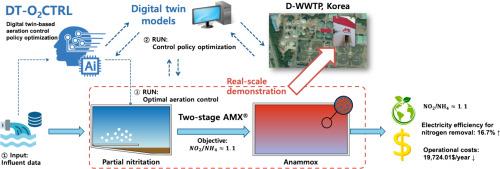Real-scale demonstration of digital twins-based aeration control policy optimization in partial nitritation/Anammox process: Policy iterative dynamic programming approach
IF 8.3
1区 工程技术
Q1 ENGINEERING, CHEMICAL
引用次数: 0
Abstract
Partial nitritation (PN) and anaerobic ammonium oxidation (Anammox) process is a promising energy-efficient nitrogen removal method in wastewater sector. Recently, artificial intelligence (AI)-driven process operation techniques are widely researched. However, there is few research to demonstrate AI application into a full-scale wastewater treatment plant (WWTP) due to operational complexity of WWTP. This study conducts a real-scale demonstration of digital twin-based aeration control policy (DT-O2CTRL) to autonomously control the full-scale PN/A process under high nitrogen influent loads. For this, chemical oxygen demand (COD) and NH4-N in influent and reactors, were collected through the online sensors. Then, digital twin (DT) model of full-scale PN/A process was mathematically developed. Finally, policy iterative dynamic programming (PIDP), inspired from the reinforcement learning, was suggested as the core algorithm of AI-O2CTRL to maintain a NO2-N/NH4-N ratio (NNR) which is a critical operation factor in PN/A process. The results showed that the DT model showed an accuracy of >95 %. Based on the DT model, the AI-O2CTRL algorithm autonomously controls the NNR at the target value of 1.1 and reduces electricity consumption by 16.7 % when treating around 400 m3/d of enriching nitrogen loads. Finally, it can reduce the operational cost by 19,724.01$/year regardless of the influent load fluctuations.

基于数字双胞胎的曝气控制策略优化在部分亚硝酸盐化/Anammox 过程中的实际规模演示:政策迭代动态编程方法
部分亚硝酸盐化(PN)和厌氧氨氧化(Anammox)工艺是污水处理领域一种前景广阔的节能脱氮方法。最近,人工智能(AI)驱动的工艺操作技术被广泛研究。然而,由于污水处理厂运行的复杂性,将人工智能应用于大规模污水处理厂(WWTP)的研究很少。本研究进行了基于数字孪生曝气控制策略(DT-O2CTRL)的实际规模演示,以在高氮进水负荷下自主控制全规模 PN/A 工艺。为此,通过在线传感器收集了进水和反应器中的化学需氧量(COD)和 NH4-N。然后,用数学方法建立了全规模 PN/A 工艺的数字孪生(DT)模型。最后,受强化学习的启发,提出了策略迭代动态编程(PIDP)作为 AI-O2CTRL 的核心算法,以维持 PN/A 过程中的关键运行因素--NO2-N/NH4-N 比值(NNR)。结果表明,DT 模型的准确率为 95%。基于 DT 模型,AI-O2CTRL 算法可将 NNR 自主控制在 1.1 的目标值,在处理约 400 立方米/天的富氮负荷时,可降低 16.7% 的电耗。最后,无论进水负荷如何波动,它都能将运行成本降低 19,724.01 美元/年。
本文章由计算机程序翻译,如有差异,请以英文原文为准。
求助全文
约1分钟内获得全文
求助全文
来源期刊

Desalination
工程技术-工程:化工
CiteScore
14.60
自引率
20.20%
发文量
619
审稿时长
41 days
期刊介绍:
Desalination is a scholarly journal that focuses on the field of desalination materials, processes, and associated technologies. It encompasses a wide range of disciplines and aims to publish exceptional papers in this area.
The journal invites submissions that explicitly revolve around water desalting and its applications to various sources such as seawater, groundwater, and wastewater. It particularly encourages research on diverse desalination methods including thermal, membrane, sorption, and hybrid processes.
By providing a platform for innovative studies, Desalination aims to advance the understanding and development of desalination technologies, promoting sustainable solutions for water scarcity challenges.
 求助内容:
求助内容: 应助结果提醒方式:
应助结果提醒方式:


